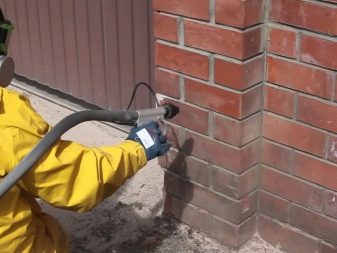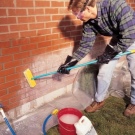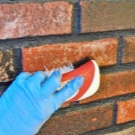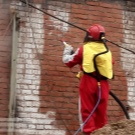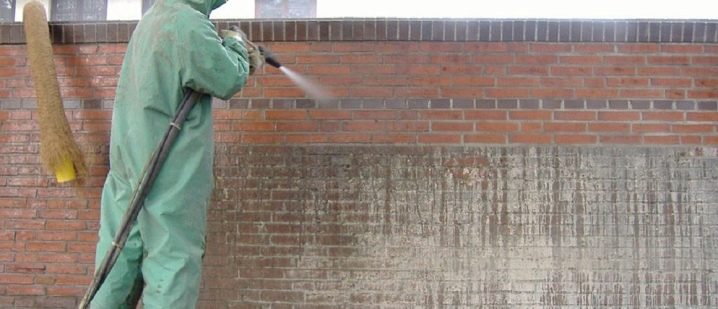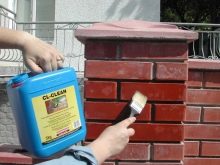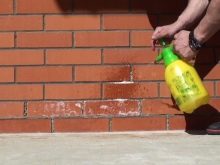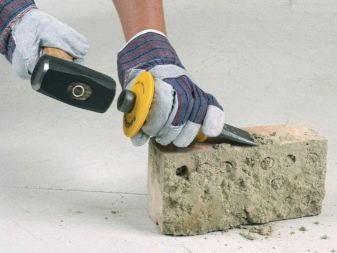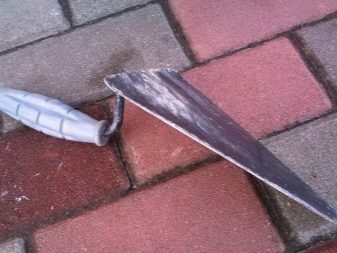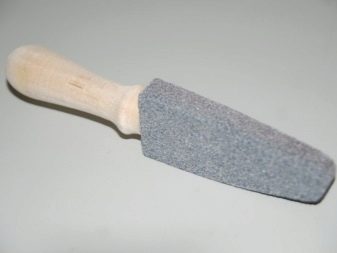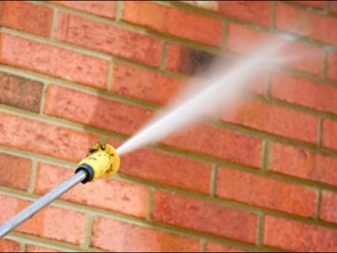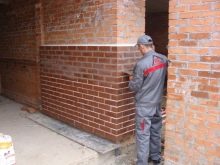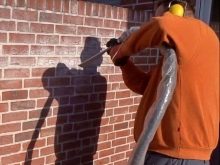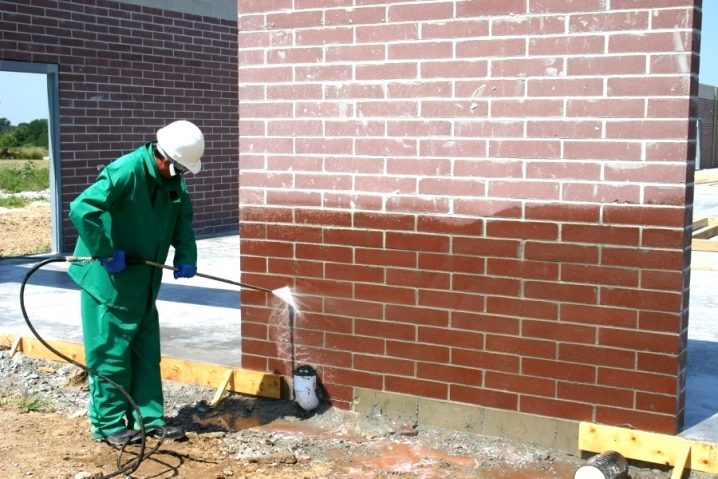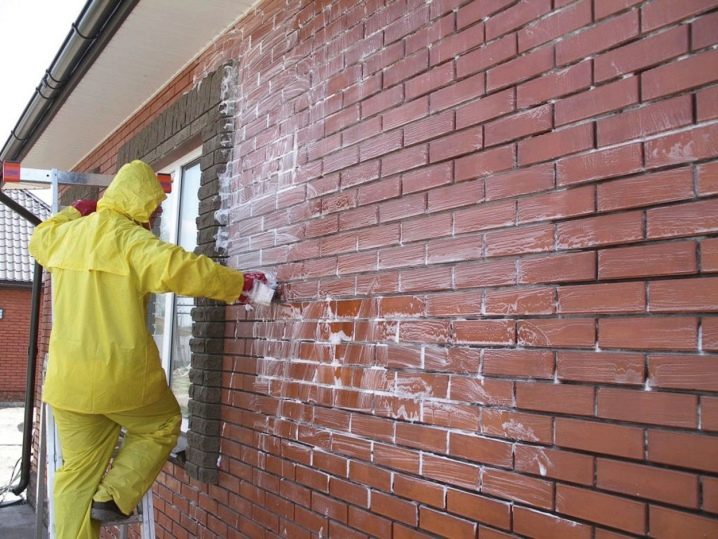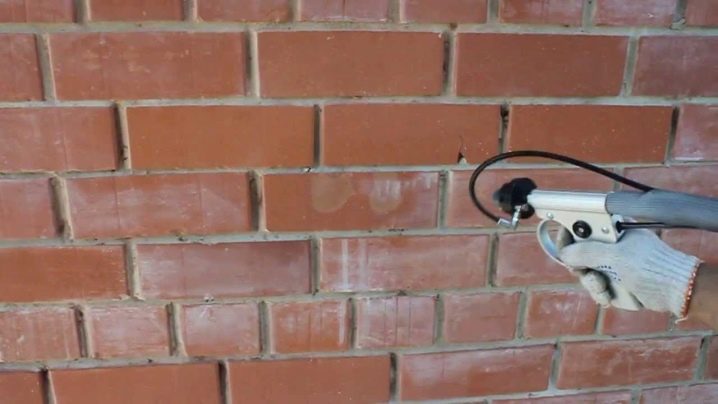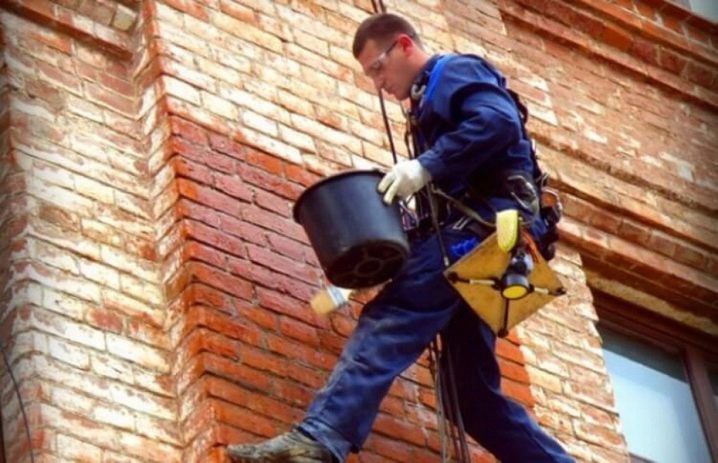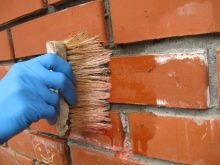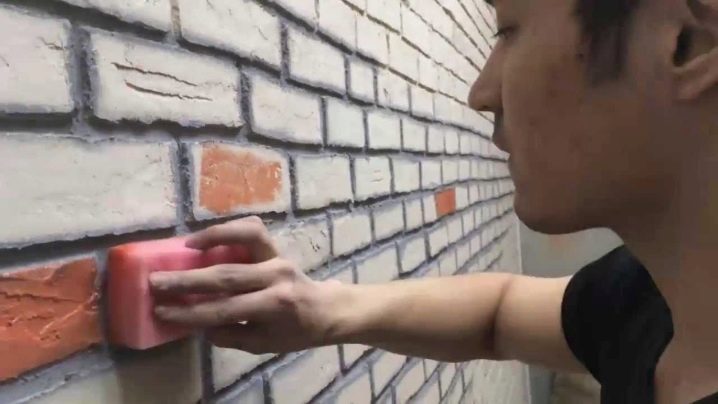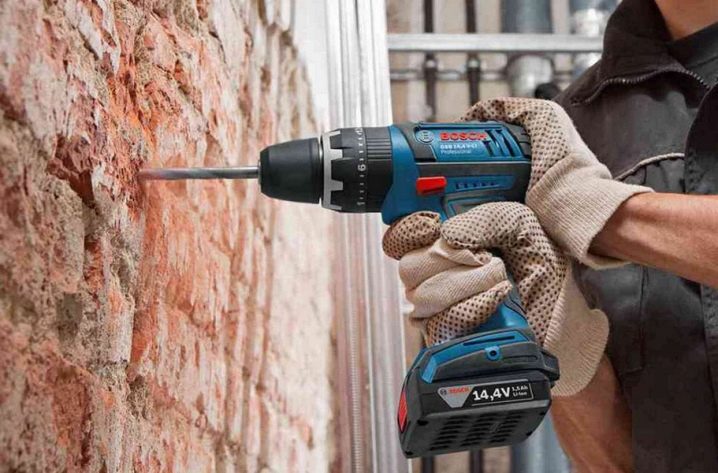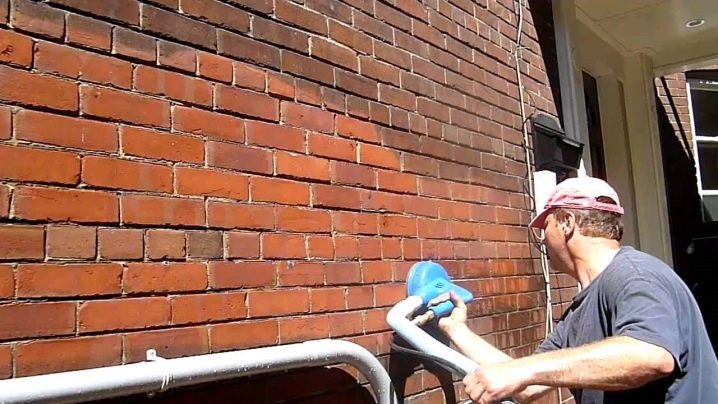Subtleties of the process of cleaning bricks
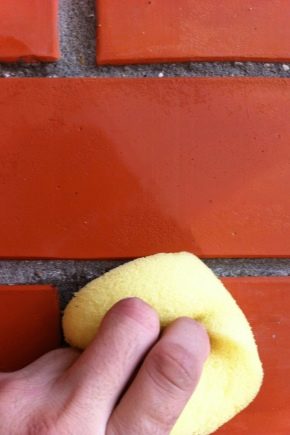
Cleanliness is important not only for everyday cleaning, but also when caring for building structures. Even the most durable brick will last longer and will please people, if it is properly cleared. And in many cases, the guidance of the elementary order only allows you to apply ceramic blocks again.
Cleaning methods
Developed various options for the purification of bricks, each of which has its own scope of application. Sometimes, if the pollution is very strong, you have to combine two or more methods. The water jet supplied under pressure effectively removes salt peels and other stains.Existing systems can supply water at a pressure of 15-220 bar. Although this pressure is large, the technology has been developed to such an extent that the material is not damaged, moreover, it is environmentally safe.
Instead of water, jets of sand can be used. Devices that feed it, can guarantee the release of bricks from the following contaminants:
- old dyes;
- bitumen;
- fuel oil and other petroleum products;
- mold spots;
- cement sprays and crusts;
- traces of corrosion.
The sand supplied under considerable pressure also exerts increased pressure on the surface. This helps to remove all inclusions that impair the appearance of the wall or another structure. Along with the two named variants, the mechanical technique is widely used. It helps to remove all hardened substances, including drips of building mixtures, paints and varnishes. For work use various manual tools, allowing to cleave cement mortar and other blockages.
But very small dirt with chisels, chisels, and so on is inconvenient to clean. In addition, they can damage the surface.Therefore, the final processing is carried out using coarse emery. To ensure a positive result, after abrasive treatment, it is necessary to rinse the brick with a stream from a hose. This will wash off all dust particles. But all mechanical effects, even the most benign, can damage a brick wall. Therefore, chemicals are also widely used. Dissolve clogs help:
- phosphoric;
- sulfuric;
- hydrochloric acid.
They are used only when processing ceramic bricks. But silicate blocks can not be cleaned in this way. It will inevitably be damaged. Cement adheres very strongly to the silicate base. It is very difficult to remove traces of the solution and excess weight with its hand tools, it is necessary to use electric machines.
Facilities
When one or another option for cleaning bricks is selected, you need to prepare special tools.
If you plan to use a mechanical method for cleaning the surface of the masonry layer, you need to prepare:
- brush for metal processing;
- trowel (sometimes replaced with a spatula);
- sandpaper covered bar;
- chisel;
- chisel;
- medium sized hammer.
In addition to mechanical cleaners, it is necessary to keep a water tank ready. It reduces the strength of dried spots. Inside the house, the wall is moistened with rollers, brushes or sponges. If the work is carried out on the street, and the pollution is very large, it is more practical to use a hose. It should avoid excessive moisture, because the brick is destroyed by contact with the liquid.
But since any manual and electric tool creates dust when working, throws away abrasive particles, you need to take care of devices to protect health. It is possible to work with the similar tool only in a respirator and special glasses. Important: you should wear gloves. Clothing when cleaning bricks should be durable, non-marking; if it gets dirty, it shouldn't be a pity. If you plan to use special chemicals, you must use the same respirators, goggles and rubber gloves.
To remove dirt from a silicate brick mechanically, apply:
- steel brushes;
- electric drills and attachments for them;
- emery.
It is necessary to wet stains and raids on silicate material in any case. This will significantly simplify the work.Solvents are bought in the finished form or prepared independently - it depends on the material capabilities and skills. In most cases, sulfuric and hydrochloric acid helps to clean the surface. Important: it is impossible to apply them in pure form and in concentrated solutions, dilution to 10% is required.
Chemical cleaning is completed by rinsing the surface with running water. This will remove corrosive substances along with undissolved particles. Special preparations are applied to contaminated areas of the brick with brushes, rollers or brushes. It is recommended to combine chemical and mechanical cleaning. The blockages softened with chemicals are removed with spatulas and chisels (if the spots are large), or steel brushes (when it is necessary to remove small traces and dots, specks).
How to clean different types of pollution with your own hands?
The choice of cleaning method is determined not only by the type of brick (ceramic or silicate), and not only by the severity of contamination. It is also necessary to pay attention to the area covered by the blockage, how quickly it should be removed from it. Emergency brick cleaning is made with special preparations.If there is no need to rush, more environmentally friendly methods are preferable. Already among them choose the approach, focusing on the type of coverage.
Immediately after laying the walls have to be cleaned of cement. First of all, the mud is softened, wetting with water. This will make the stone more fragile, help to tear it from the base material. Watering is continued until water continues to be absorbed. If it is still absorbed, it means that the spot safety margin has not yet been exhausted.
Next, the solution is removed mechanically. If the spots of concrete have a flat shape, they are usually removed with spatulas, trowels or brushes of increased rigidity. If there are stone fragments on the surface, they are slightly beaten off with a spatula. What remains will be cleaned with a brush. But the big inclusions will remove only the chisel and the hammer; other tools are impractical. During the work it is necessary to strike blows precisely and without excessive effort. Absolutely unacceptable strikes at right angles. Pressure on contaminated sites should be up or down against the wall. When the waste coating is largely removed, the brick wall will have to be sanded.But the work does not end there - one must still wash the surface, thereby getting rid of microscopic particles.
If the wall has stood for a long time, often have to get rid of salt. The approach to the raids can vary significantly depending on their nature. A part of the salt stains are simply washed away, watering the facade or individual bricks with a hose. Sometimes you do not even need to create a strong pressure, just enough wetting. But in other cases, stronger means are required - special preparations and a stiff brush.
Important: Reagents sold in stores can deal only with strictly defined types of mineral salts.
To restore the appearance of the old brick to normal, you will have to either act by trial and error, or be guided by the recommendations of the sellers. They need to describe in detail the type of stains, layers (and better to show photos). Diluting any drug, it is unacceptable to deviate from the ratios of water and working mixture prescribed by the instruction; The recommended processing time can not be exceeded.
From the available chemical means to combat the salt blockages apply a solution of hydrochloric acid.They can only be wetted with a thoroughly moistened substrate. When 10 minutes pass, the wall is washed out with a hose. As soon as the surface dries to 100%, it must be treated with a hydrophobic substance. If everything is done correctly, in the next 10 years new salt spots will not appear on the surface.
Brick walls on the street are often covered with dried clay. This type of pollution is considered easy to clean. Even if the clay covers a significant part of the surface, you can get rid of it just by wetting the polluted places. After 5-7 minutes, you can shoot down the dirt with a stream from a hose. Large clay fragments located in easily accessible places are removed with a brush, and then the problem area is washed. But a brick can be clogged not only with clay - often it gets paint of various kinds. With any construction paints, as well as with resin and bitumen, help to cope with:
- kerosene;
- White Spirit;
- turpentine.
Problem areas are rubbed with an unnecessary cloth moistened in the chosen remedy. The same three substances will help get rid of grease stains. Important: when using turpentine and kerosene it is necessary to remember about their flammability, and white spirit is also toxic.In addition to fatty substances and paints, often brick walls have to be removed from plaster. One method involves uniform wetting of the material with a spray.
When it takes 3-5 minutes, the decorative coating is easily removed with a trowel or spatula. But after abundant impregnation with water, the plaster can also be knocked down with a stream of water from a hose. The small remains and single spots clean a steel brush. More productive way - the use of an electric drill. It is only necessary to put on it special grinding nozzles. The brickwork of the stove, the fireplace regularly has to be cleaned of soot and soot. In both cases, apply detergent from grease stains with a brush. Attention: if the stain is already old, it is advisable to take compositions with organic solvents. They are much more active than ordinary cleaning products. Because time and effort is spent less.
Useful tips
In any case, whatever pollution may appear on the brick wall, after cleaning it is desirable to wash and dry it. After that, water repellents are used to improve the design characteristics.Use a chisel to remove dirt should be in the last turn. It is not intended to remove cement (concrete) and can quickly become dull. Contrary to the recommendations of individual "professionals", it is impossible to tear off cement from bricks with nails - they will certainly leave traces that spoil the appearance.
How to clean the brick with your own hands, see the next video.




